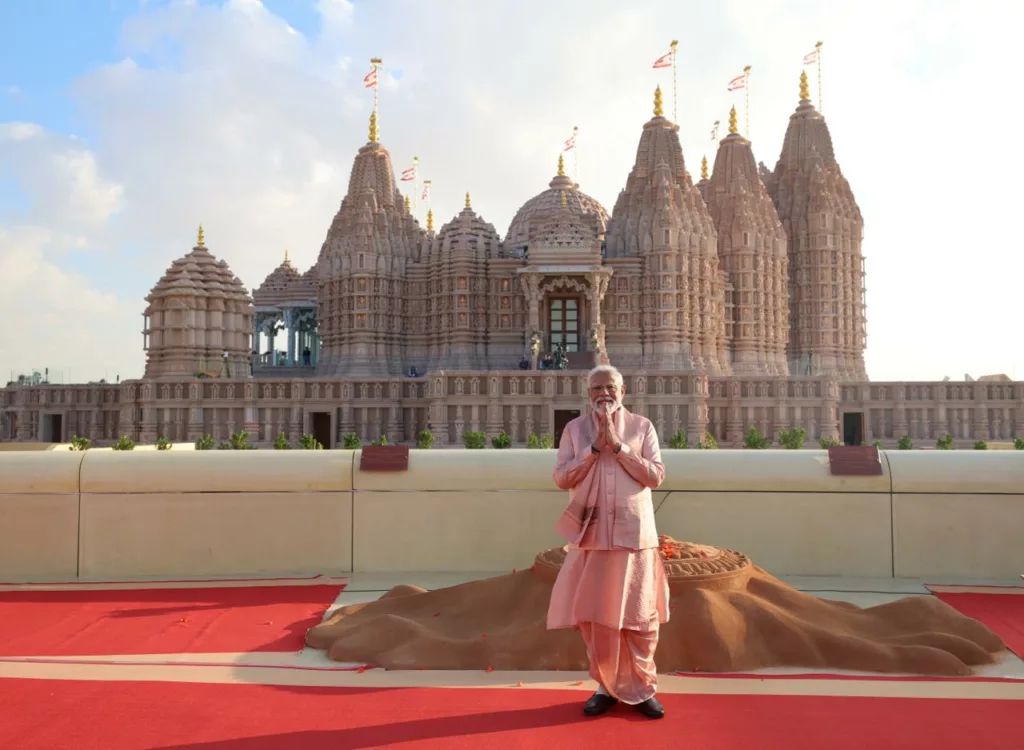
BAPS Hindu Mandir Abu Dhabi, which was inaugurated with great ceremony on February 14 by Indian Prime Minister Narendra Modi, has received more than 350,000 visitors and devotees within the first month of its opening, according to the temple authorities.
The iconic BAPS temple, the first of its kind and scale in the Middle East, was fully opened for visitors on March 1. “In the first month, there were approximately 350,000 devotees and visitors, 50,000 of whom visited each weekend (Saturday-Sunday). It’s important to note that on Mondays, the Mandir conducts private prayers and is closed to visitors, meaning the complex was accessible for only 27 out of the 31 days in March,” said a temple spokesperson, speaking to the Press Trust of India on April 3.
Also see: In Pics: BAPS Hindu Mandir in Abu Dhabi

“Every evening from Tuesday to Sunday, Ganga Aarti is performed at 7.30pm on the banks of the Swaminarayan ghat, which has been created [at the temple] using holy water from Ganga and Yamuna, transported from India,” he added.

The grand temple was inaugurated during a dedication ceremony attended by over 5,000 invitees on February 14. The temple has been built by the BAPS Swaminarayan Sanstha on a 27-acre site in Abu Mureikhah, near Al Rahba off the Dubai-Abu Dhabi Sheikh Zayed Highway, at a cost of around INR 700 crore (USD 83.8 million).
Constructed with sandstone sourced directly from Rajasthan, in western India, the Hindu Mandir in Abu Dhabi has been made in the Nagara style of architecture, just like the Ram Temple in Ayodhya, which was inaugurated earlier this year.
BAPS Hindu Mandir is the largest in the Gulf region. The UAE has three other Hindu temples, located in Dubai.
“Since the temple is [a] little on the outskirts and in the middle of a desert, public bus service from the city has been started for weekends to allow visitors to easily come to the temple,” the spokesperson said.

During PM Modi’s two-day visit to the Gulf nation in 2015, the UAE allocated land for constructing a temple in Abu Dhabi. This visit held significant diplomatic importance, as Modi became the first Indian prime minister since Indira Gandhi to visit this strategically vital Gulf nation in 34 years.

Seven spires representing seven emirates of the UAE; carvings of camels, aka the “ships of the desert”; and the UAE’s national bird falcon are part of the architecture of the first Hindu stone temple in Abu Dhabi, to give equal representation to the host country. Alongside are animals that occupy an important place in Indian mythology, such as elephants and lions.
Apart from 15 tales from India, including the Ramayan and Mahabharat, stories from Mayan, Aztec, Egyptian, Arabic, European, Chinese, and African civilisations have also been depicted in the temple.
While the outer walls of the temple are made using sandstone from India, the interior, made of white Italian marble, is adorned with intricately designed and carved columns and walls.


